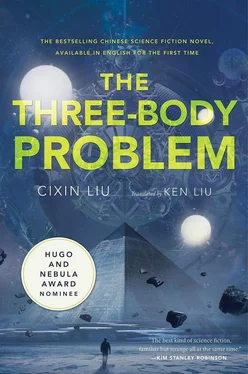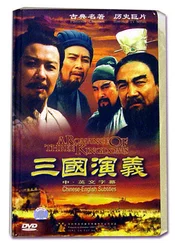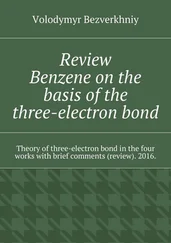Commissar Lei placed a hand on Ye’s shoulder. She felt the warmth and strength conveyed through it. “Wenjie, let me tell you my sincere hope: One day, I’d like to call you Comrade Ye .”
Lei stood up and strode away in the confident manner of a soldier. Ye’s eyes were filled with tears. Seen through them, the code on the screen became flickering flames. This was the first time she had cried since the death of her father.
As Ye familiarized herself with the work of the Monitoring Department, she discovered that she was far less successful here than at the Transmission Department. The computer science knowledge she had was outdated, and she had to learn the software techniques from scratch. Even though Commissar Lei trusted her, the restrictions on her were severe. She was allowed to view the software source code, for example, but was forbidden from touching the database.
On a day-to-day basis, Ye was mainly supervised by Yang. He became even ruder to her, and would get angry at her for the smallest things. Commissar Lei talked to him about it multiple times without effect. It seemed that Yang became filled with a nameless anxiety as soon as he saw Ye.
Gradually, as Ye encountered more and more unexplainable matters in her work, she came to realize that the Red Coast Project was far more complex than she had imagined.
One day, the monitoring system intercepted a transmission that, after being deciphered by the computer, turned out to be a few satellite photographs. The blurry images were sent to the General Staff Department’s Surveying and Mapping Bureau for interpretation. They turned out to be images of important military targets in China, including the naval harbor at Qingdao and several key factories of the Third Front program. [26] Translator’s Note: The Third Front program was a secret, military-led industrialization effort during the Cultural Revolution that built factories in China’s interior, where they would be less vulnerable to American and Soviet attacks.
Analysis confirmed that these images came from the KH-9 American reconnaissance system.
The first KH-9 satellite had just been launched. Although it mainly relied on recoverable film capsules for intelligence gathering, it was also being used to test out the more advanced technique of radio transmission of digital images. Due to the technology’s immaturity, the satellite transmitted at a low frequency, which increased its range of reception sufficiently for it to be intercepted by Red Coast. And because it was only a test, the encryption was not very secure and could be broken.
The KH-9 was without a doubt an important monitoring target, as it presented a rare opportunity to gather more information about American satellite reconnaissance systems. Yet, after the third day, Yang Weining ordered a change in the frequency and direction of monitoring and abandoned the target. Ye found the decision incomprehensible.
Another event also shocked her. Even though she was now in the Monitoring Department, sometimes the Transmission Department still needed her. One time, she accidentally saw the frequency settings for a few upcoming transmissions. She discovered that the designated frequencies for transmissions 304, 318, and 325 were lower than microwave range and could not result in any heating effect in the target.
One day, an officer summoned Ye to the main base administrative office out of the blue. From the officer’s tone and expression, Ye knew that something had gone wrong.
As she walked into the office, the scene before her seemed familiar: All the senior officers of the base were present, along with two officers she didn’t know. However, she could tell at a glance that they were from higher up in the chain of command.
Everyone’s icy stares focused on her, but the sensitivity she had developed over the stormy years informed her that she wasn’t the one in big trouble today. She was at most a sideshow. She saw Commissar Lei sitting in a corner with a dejected look.
He’s finally going to pay for trusting me, she thought. At once, she decided that she would do whatever she could to save him. She would take responsibility for everything, even lie if necessary.
But Commissar Lei was the first to speak, and what he said was completely unexpected. “Ye Wenjie, I must make it clear at the start that I do not agree with what is about to be done. The decision was made by Chief Engineer Yang after requesting instructions from our superiors. He alone will be responsible for all consequences.”
Commissar Lei turned to look at Yang, who nodded solemnly. Lei continued, “In order to better utilize your skills at Red Coast Base, Chief Engineer Yang repeatedly requested permission from our superiors to abandon the cover story we’ve been using with you. Our comrades from the Army Political Department”—he indicated the two officers Ye didn’t know—“were sent to investigate your work situation. Finally, with the approval of our superiors, we’ve decided to inform you of the true nature of the Red Coast Project.”
Only after a long pause did Ye finally understand Commissar Lei’s meaning: He had been lying to her all along.
“I hope you will treasure this opportunity and work hard to redeem your sins. After this, you must behave with the utmost propriety. Any reactionary behavior will be severely punished!” Commissar Lei stared at Ye. He was a completely different person from the image Ye had formed of him. “Are we clear? Good. Now Chief Yang can explain.”
The others left, leaving only Yang and Ye.
“If you don’t want this, there’s still time.”
Ye discerned the weight behind these words. She now understood Yang’s anxiety whenever he had seen her the last few weeks. To make full use of her skills, it was necessary for her to know the truth about Red Coast. However, this choice would extinguish the last ray of hope she had of ever leaving Radar Peak. Once she said yes, she really would spend the rest of her life at Red Coast Base.
“I agree,” Ye said, softly, but resolutely.
Thus, on this early summer evening, as the wind howled through the giant parabolic antenna, and as the forest rustled over the Greater Khingan Mountains in the distance, Yang Weining explained to Ye Wenjie the true nature of Red Coast.
It was a fairy tale for the ages, even more incredible than the commissar’s lies.
SELECTED DOCUMENTS FROM THE RED COAST PROJECT
These documents were declassified three years after Ye Wenjie told Wang Miao the inside story of Red Coast and provide background information for what she told him.
I.
A Question Largely Ignored by Trends in Fundamental World Scientific Research
(Originally published in Internal Reference, XX/XX/196X)
[ Abstract] Based on modern and contemporary history, there are two ways in which the results of fundamental scientific research can be converted into practical applications: gradualistic mode and saltatory mode.
Gradualistic mode: theoretical, fundamental results are gradually applied to technology; advances accumulate until they reach a breakthrough. Recent examples include the development of space technology.
Saltatory mode: theoretical, fundamental results rapidly become applied technology, leading to a technological leap. Recent examples include the appearance of atomic weapons. Until the forties, some of the foremost physicists still thought it would never be possible to release the energy of the atom. But atomic weapons then appeared within a very short period. We define a technology leap to occur when fundamental science is converted to applied technology across a great span in an extremely brief time interval.
Читать дальше












